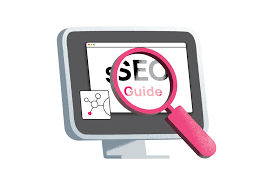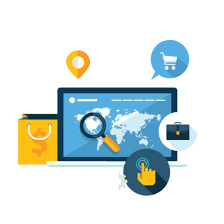Digital Marketing for Dummies: A Beginner’s Guide
In today’s digital age, having a strong online presence is essential for any business to succeed. However, with so many digital marketing strategies and tools available, it can be overwhelming for beginners to know where to start. That’s why we’ve put together this beginner’s guide to digital marketing.
What is Digital Marketing?
Digital marketing refers to any form of marketing that uses electronic devices or the internet. This includes social media marketing, email marketing, search engine optimization (SEO), content marketing, pay-per-click (PPC) advertising, and more.
Why is Digital Marketing Important?
With the majority of consumers now using the internet to research products and services before making a purchase, having a strong online presence is crucial for businesses. Digital marketing allows you to reach your target audience where they spend most of their time – online.
Getting Started with Digital Marketing
- Define Your Goals: Before starting any digital marketing campaign, it’s important to define your goals. What do you want to achieve? Do you want to increase website traffic? Generate leads? Boost sales? Defining your goals will help you determine which strategies and tools are best suited for your business.
- Know Your Target Audience: Understanding your target audience is key to creating effective digital marketing campaigns. Who are they? What are their interests and behaviors? Where do they spend their time online?
- Build Your Website: Your website is the foundation of your online presence. Make sure it’s user-friendly and optimized for search engines.
- Create Quality Content: Content is king in digital marketing. Create high-quality content that provides value to your target audience.
- Utilize Social Media: Social media platforms like Facebook, Twitter, Instagram, and LinkedIn can be powerful tools for reaching your target audience and driving traffic back to your website.
- Implement SEO: SEO involves optimizing your website content and structure so that it ranks higher in search engine results pages (SERPs).
- Use Paid Advertising: PPC advertising can be an effective way to drive traffic to your website and generate leads.
- Measure Your Results: To determine the effectiveness of your digital marketing campaigns, it’s important to measure your results. Use tools like Google Analytics to track website traffic, conversion rates, and more.
Conclusion
Digital marketing may seem intimidating at first, but with the right strategies and tools, it can help you reach your target audience and achieve your business goals. By defining your goals, understanding your target audience, creating quality content, utilizing social media, implementing SEO, using paid advertising, and measuring your results, you can create a strong online presence that drives traffic and boosts sales.
Digital Marketing 101: Answers to Frequently Asked Questions for Beginners
- What is the basics of digital marketing?
- What are the 7 C’s of digital marketing?
- What are the 5 D’s of digital marketing?
- How to do digital marketing for beginners?
What is the basics of digital marketing?
The basics of digital marketing include any form of marketing that uses electronic devices or the internet. This includes social media marketing, email marketing, search engine optimization (SEO), content marketing, pay-per-click (PPC) advertising, and more.
To get started with digital marketing, it’s important to define your goals and understand your target audience. Building a user-friendly website that is optimized for search engines is also crucial. Creating high-quality content and utilizing social media platforms can help you reach your target audience and drive traffic back to your website.
Implementing SEO involves optimizing your website content and structure so that it ranks higher in search engine results pages (SERPs). Paid advertising, such as PPC advertising, can also be an effective way to drive traffic to your website and generate leads.
Measuring results is important in determining the effectiveness of your digital marketing campaigns. Utilizing tools like Google Analytics can help you track website traffic, conversion rates, and more.
Overall, the basics of digital marketing involve creating a strong online presence that reaches your target audience where they spend most of their time – online. By utilizing various strategies and tools, businesses can achieve their goals and succeed in today’s digital age.
What are the 7 C’s of digital marketing?
The 7 C’s of Digital Marketing are:
- Content: Creating relevant and engaging content that resonates with your target audience.
- Context: Understanding the context in which your content will be consumed, such as the device, location, and time of day.
- Connection: Building a strong connection with your audience through personalized experiences and interactions.
- Community: Fostering a sense of community around your brand by engaging with your audience on social media and other platforms.
- Commerce: Providing seamless e-commerce experiences that make it easy for customers to purchase products or services.
- Customization: Tailoring your marketing efforts to individual customers based on their preferences, behaviors, and past interactions with your brand.
- Conversion: Optimizing your digital marketing efforts to drive conversions and achieve business goals, such as increasing sales or generating leads.
By focusing on these 7 C’s of digital marketing, businesses can create effective strategies that engage their target audience, build brand loyalty, and drive revenue growth.
What are the 5 D’s of digital marketing?
The 5 D’s of Digital Marketing are:
- Digital Devices: The first D refers to the various digital devices that people use to access the internet, such as desktop computers, laptops, smartphones, and tablets. It’s important for businesses to consider how their digital marketing strategies will appear on these devices and ensure that they are optimized for each platform.
- Digital Platforms: The second D refers to the different digital platforms where businesses can reach their target audience, such as social media platforms like Facebook and Twitter, search engines like Google and Bing, email marketing platforms, and more. Understanding which platforms are most effective for reaching your target audience is key to creating successful digital marketing campaigns.
- Digital Media: The third D refers to the various types of digital media that businesses can use in their marketing efforts, such as videos, images, infographics, podcasts, and more. Using a variety of media types can help keep your audience engaged and interested in your content.
- Digital Data: The fourth D refers to the vast amount of data that is available through digital marketing efforts. This includes data on website traffic, social media engagement rates, email open rates and click-through rates (CTR), conversion rates, and more. Analyzing this data can provide valuable insights into how your marketing campaigns are performing and where you can improve.
- Digital Technology: The fifth D refers to the various technologies that businesses can use to optimize their digital marketing efforts. This includes tools for search engine optimization (SEO), pay-per-click (PPC) advertising management software, email marketing automation tools, social media management platforms, and more.
By considering these 5 D’s of Digital Marketing when creating your strategy, you can ensure that your campaigns are optimized for success across all digital channels and devices.
How to do digital marketing for beginners?
Digital marketing can seem overwhelming for beginners, but with the right strategies and tools, it can be an effective way to grow your business. Here are some tips on how to get started with digital marketing:
- Define Your Goals: Before starting any digital marketing campaign, it’s important to define your goals. What do you want to achieve? Do you want to increase website traffic? Generate leads? Boost sales? Defining your goals will help you determine which strategies and tools are best suited for your business.
- Know Your Target Audience: Understanding your target audience is key to creating effective digital marketing campaigns. Who are they? What are their interests and behaviors? Where do they spend their time online?
- Build Your Website: Your website is the foundation of your online presence. Make sure it’s user-friendly and optimized for search engines.
- Create Quality Content: Content is king in digital marketing. Create high-quality content that provides value to your target audience.
- Utilize Social Media: Social media platforms like Facebook, Twitter, Instagram, and LinkedIn can be powerful tools for reaching your target audience and driving traffic back to your website.
- Implement SEO: SEO involves optimizing your website content and structure so that it ranks higher in search engine results pages (SERPs).
- Use Paid Advertising: PPC advertising can be an effective way to drive traffic to your website and generate leads.
- Measure Your Results: To determine the effectiveness of your digital marketing campaigns, it’s important to measure your results. Use tools like Google Analytics to track website traffic, conversion rates, and more.
Remember that digital marketing is an ongoing process that requires consistent effort and attention. By following these tips, you can create a strong online presence that drives traffic and boosts sales for your business.




